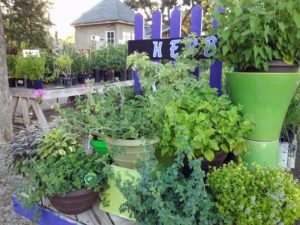Now is the time we find ourselves dreaming of summer vegetable gardens soon to be planted. Consider adding an herb garden to round out the flavor palate. Herbs can slip into a small pot or a corner of the garden, they require very little growing time before they are useful and they add a lot of pop to barbecued meals, salads and side dishes.
Try grilling chicken with an oregano, chive, and basil marinade or filling a roasting chicken with rosemary, garlic and oregano. Potatoes take on an entirely different flavor when roasted with a basting of olive oil and rosemary, chives or dill. Take a few minutes and add herbs to the vegetable garden. You’ll find that their magic can add a savory taste to all your cooking!
BASIL (cold sensitive – plant outside when the weather warms, late March or beyond)
Basil adds zest and color to bottled vinegar, use this when preparing a fresh salad dressing. Basil is great for salads, marinades or fresh fish dishes. The most popular basil is sweet basil with its fragrant leaves. Use it in pesto, sprinkle it with chopped garlic on prime rib, and use it liberally in Italian dishes. Basil also makes a bright accent in the flower garden. Basil plants have the added benefit of repelling flies. Enjoy as “window sill basil” to get the season going.
CHIVES
This spiky plant looks like a cluster of onions. In late May it is crowned with lavender flowers. Clip and chop handfuls of it to season potato dishes, salads, dressings, egg dishes, and soups. It is one of the most versatile kitchen herbs. You can flavor white vinegar with a few stems of this herb and enjoy it splashed over garden ripened tomatoes.
DILL
Used for pickling, dill is also wonderful in salads, sauces, soups or breads on vegetables and fish. Special tips: Try pickling green beans, carrots, new potatoes or peppers with a bit of dill.
LAVENDER
The addition of culinary grade lavender in tiny amounts can jazz up dishes as diverse as grilled pork chops, to scones, cakes, and even candy.
MARJORAM
Like oregano but sweeter, this flavor is perfect in Mediterranean dishes, meats, and vegetables.
MINT
The flavor of mint is refreshing, cool and sweet, especially good in iced drinks and teas, with lamb or in salad dressings. Special tips: Minty sun tea: Put 8 tea bags, ½ c. of fresh mint leaves and 1 gal. of water in a clear glass jar. Set in a sunny spot for several hours. Serve over ice, or simply make iced mint water. It’s so refreshing! Mint tends to overgrow its neighbors and proliferate in the garden – consider a separate pot to contain this enthusiastic grower.
OREGANO
This pungent herb is no foreigner to cooking. Use it in marinade; grind it to add to pizza, spaghetti sauce or salad dressings. And one summer favorite is to add it with fresh basil to an oil and vinegar marinade for fresh from the garden flavor.
PARSLEY
For a clean sharp and peppery taste, add to vegetables and salads as a garnish. Include in sauces, soups, stews and stuffing. Special tips: Parsley is high in Vitamins A, C and B.
ROSEMARY
Wonderful flavoring for chicken or any barbecue. Evergreen, woody shrub has aromatic foliage (It’s actually related to mint.) The flavor of rosemary is bold and piney. Use it in pickles, jams, preserves and sauces, as well as meats and soups. Special tips: Use a branch of rosemary as a basting brush at your next barbecue, or put some on the coals for a great aroma. Plant in full sun.
SAGE
Warm, slightly bitter, this flavor is a must for turkey stuffing, as well as pork, duck and sausage seasoning. Special tips: Dried sage leaves are used as a substitute for coffee or tea.
TARRAGON
A spicy, sharp flavor with licorice and mint overtones, tarragon lends itself to French cooking, egg dishes, fish, and salad dressing. Special tips: Tarragon vinegar: Pour a qt. of cold vinegar over ½ c. fresh tarragon leaves, cap and store for 4 weeks.
THYME
Thyme is another popular herb known of its culinary and medicinal properties. It has a concentrated herbal flavor with sharp grass, woody and floral notes. Thyme leaves can be added, whole or chopped, to a dish at any stage of cooking although the longer they cook, the more flavor they’ll provide.
Follow us in Social Media
